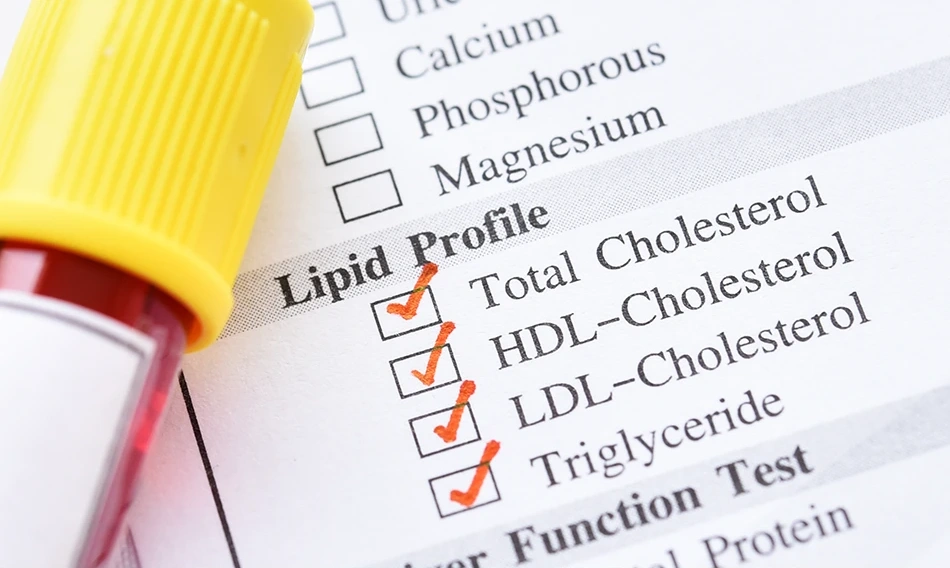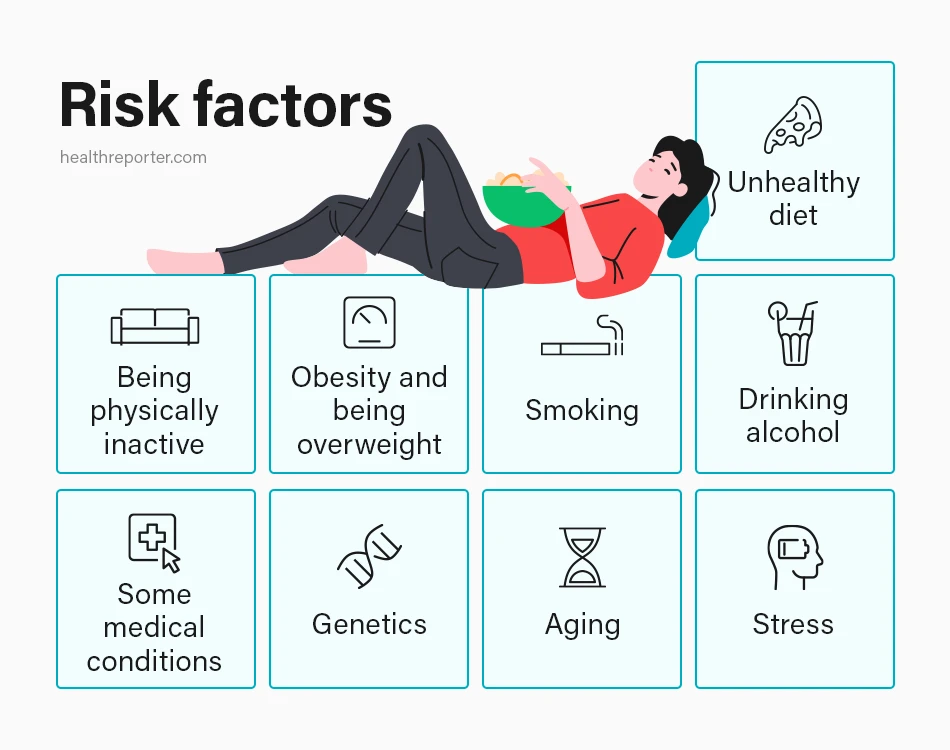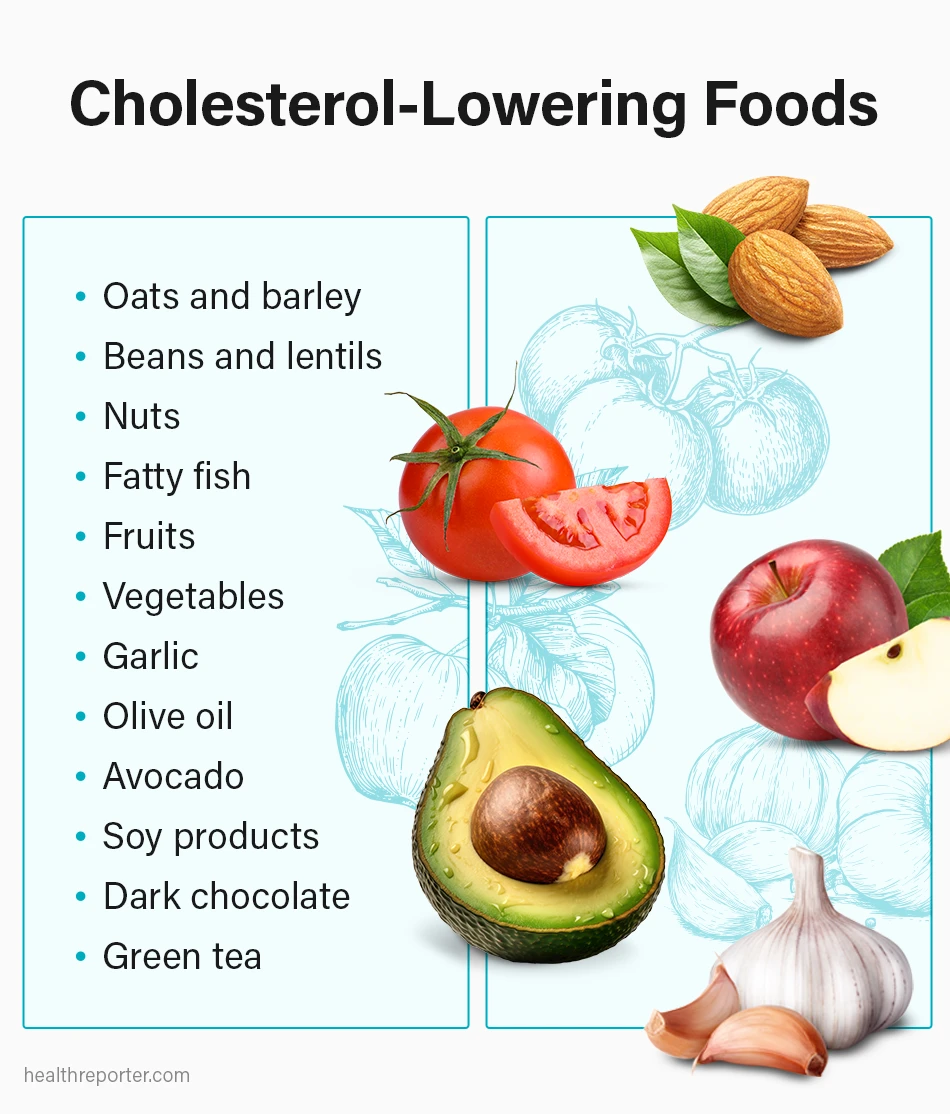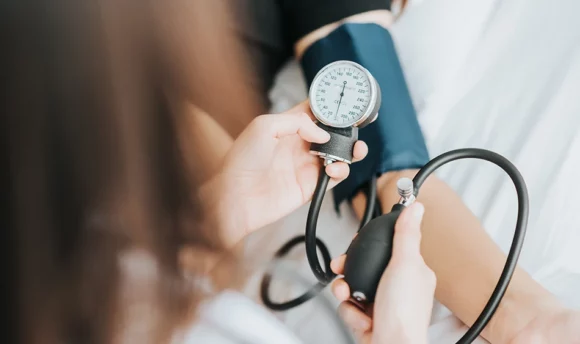Cholesterol 101: Myths, Facts, and What You Need to Know
We explore cholesterol basics, helping you understand what it is and why it matters.

Cholesterol has a reputation for being bad for your heart. But while cholesterol can harm your heart, it’s also an integral part of your health. Because of its dual nature, conflicting messages often leave people unsure about how to manage their cholesterol levels.
This article provides clarity on cholesterol, from its critical function to its adverse effects on the cardiovascular system. With an understanding of the balance between good and bad cholesterol, you can make informed choices about how to ensure your heart’s well-being.
Cholesterol: What Is It?
Cholesterol is a fatty, waxy substance that’s present in your cell membranes. The liver makes approximately 80% of all cholesterol in your body, which it uses to create hormones, make vitamin D, and produce bile acids that help you break down and absorb dietary fats.
The remaining 20% of cholesterol comes from the animal-based foods you eat, including meat, poultry, and dairy products. Your body doesn’t need dietary cholesterol to function – the liver makes all the cholesterol needed to stay healthy.
The body packages cholesterol, along with other fats, into tiny particles called lipoproteins, which travel through your bloodstream. There are two lipoproteins associated with cholesterol, and these are high-density lipoprotein and low-density lipoprotein. Maintaining the right balance between the two is critical for a healthy circulatory system.
Cholesterol Levels: Why Should You Care About It?
Caring about your cholesterol is important because this fatty substance significantly influences your cardiovascular health. You need cholesterol in your blood to survive, but too much cholesterol can increase your heart disease and stroke risk. Because high blood cholesterol doesn’t present symptoms, checking your levels is even more essential.
The amount of total cholesterol, high-density lipoprotein, and low-density lipoprotein in your blood determines if you have healthy cholesterol levels. These lipoproteins differ in their roles, with one considered “good” and the other “bad.”
So, striking the right balance between good and bad cholesterol is critical for health.
Normal cholesterol levels
The only way to know the state of your cholesterol levels is to get your cholesterol checked. In the US, the measurement is milligrams (mg) of cholesterol per deciliter (dL) of blood. The normal range is:
- Total cholesterol: Less than 200mg/dL
- LDL cholesterol: Less than 100mg/dL
- HDL cholesterol: Above 60mg/dL
- Triglycerides: Less than 150mg/dL
What Is HDL Cholesterol?
High-density lipoprotein, or HDL cholesterol, is “good” cholesterol because it absorbs cholesterol circulating in the bloodstream and returns it to the liver. The liver then excretes the excess cholesterol from your body, preventing plaque buildup and keeping your levels within the healthy range.
Higher levels of HDL cholesterol decrease your risk for heart disease and stroke.
HDL cholesterol normal range
In terms of HDL cholesterol, the higher the number, the healthier your levels are. For both men and women, the desirable HDL cholesterol level is 60mg/dL or above. Men who have levels lower than 40mg/dL, and women less than 50mg/dL, are at a higher risk of cardiovascular conditions such as atherosclerosis and heart disease.
What Is LDL Cholesterol?
Low-density lipoprotein, or LDL cholesterol, is often called “bad” cholesterol because it transports cholesterol to body tissues but, in excess amounts, can stick to your artery walls and collect. This buildup of cholesterol, called plaque, clogs and stiffens the arteries, restricting blood flow to your heart and other organs.
The heart must work harder to pump blood through the arteries, which may result in heart disease over time. If the arteries block entirely, it can cause a heart attack or stroke.
LDL cholesterol normal range
Both women and men should aim for their LDL cholesterol level to be under 100mg/dL. Levels of 101–159mg/dL are elevated and indicate that there may be too much cholesterol buildup in your arteries. High cholesterol is considered to be anything greater than 160mg/dL, which is dangerous as it can prevent normal blood flow.
What Is VLDL Cholesterol?
VLDL cholesterol means very low-density lipoprotein, another type of lipoprotein that the liver makes and releases into the bloodstream. It comprises approximately 10% proteins and 90% lipids, around 70% of which is a type of fat called triglycerides. Unlike LDL cholesterol which mostly carries cholesterol to tissues, VLDL cholesterol primarily delivers triglycerides.
Your body needs some VLDL cholesterol to maintain functions like regulating blood pressure and storing energy. However, it is another form of “bad” cholesterol because high levels can result in plaque deposits on the artery walls, contributing to heart disease and stroke risk.
VLDL levels rise when triglyceride levels rise, but it’s more tricky to monitor than other cholesterol types since there is no direct test to measure it. Instead, the VLDL cholesterol test estimates levels as a percentage of your triglycerides.
How Is High Cholesterol Diagnosed?
You can only discover if you have high cholesterol with a blood test performed by a healthcare professional. The lipid panel or lipid profile test determines the amount of cholesterol and triglycerides in your blood. The results reveal your risk of cardiovascular disease, including coronary artery disease.
Cholesterol tests calculate levels of:
- Total cholesterol
- Low-density lipoprotein (LDL) cholesterol
- High-density lipoprotein (HDL) cholesterol
- Triglycerides
After reviewing your test results, your doctor can confirm if you have high levels of cholesterol circulating in your bloodstream. If you have a high cholesterol reading, your healthcare team will discuss steps to help lower it, including making lifestyle changes.
You can pay attention to your cholesterol at home using a cholesterol-tracking app. These apps include helpful tools, such as meal planning and exercise tracking, to help you form positive habits. You can also use blood pressure apps and blood pressure monitors for a comprehensive approach to heart health.
What Causes High Cholesterol Levels?

High cholesterol is when too much of the waxy substance builds up in your blood, but what causes too much cholesterol? According to science, there are several risk factors for high cholesterol, some of which you can control and others that are out of your hands.
Risk factors include:
- Consuming a diet with too many saturated fats and trans fats
- Being physically inactive
- Obesity and being overweight
- Smoking
- Drinking alcohol
- Medical conditions such as type 2 diabetes, kidney disease, and liver disease
- Genetics and family history of high cholesterol
- Aging
Lifestyle Habits to Improve High Cholesterol Levels

While you can’t control your genes or family history, you can control other risk factors connected to living an unhealthy lifestyle. Implementing healthy habits can transform your lifestyle and return your blood cholesterol levels to the normal range. Here’s how to begin:
#1 Try to maintain a healthy weight
Weight management is an integral part of cholesterol management. Obesity is one of the top risk factors for high cholesterol because it influences how your body makes and uses cholesterol. It can cause LDL levels to increase and HDL levels to decrease.
Losing excess weight can improve high cholesterol levels. In one study, patients who lost 5–10% of total body weight found significant reductions in triglycerides, total cholesterol, and LDL cholesterol. There were even greater improvements in those who lost more than 10%.
#2 Focus on heart-healthy foods
Your diet is a great place to start because what you eat influences your cholesterol levels. Heart-healthy foods promote heart health by reducing your risk of heart disease, high cholesterol, high blood pressure, and type 2 diabetes.
Reducing saturated and trans fats in favor of heart-healthy fats will improve blood cholesterol levels. It also helps to limit your consumption of sodium and sugar.
Make sure your diet comprises a variety of fruit and vegetables, whole grains, protein-dense foods like fatty fish and eggs, and healthy fats from avocado, olive oil, nuts, and seeds.
You might be tempted to skip foods with a high cholesterol content for fear of increasing your levels. However, this is not the case when foods are low in saturated fatty acids. For example, shrimp is high in cholesterol but can benefit your heart because it contains omega-3 fatty acids, which reduce triglyceride levels.
#3 Stay physically active
Engaging in physical activity stimulates enzyme production, and these enzymes help carry the LDL cholesterol to the liver for excretion, freeing up your bloodstream from the excess.
Scientific research confirms the positive effects of endurance training on cholesterol levels, with reductions in LDL and triglyceride levels and significant improvements in HDL levels. You could try various aerobic activities like walking, cycling, running, and swimming.
#4 Engage in stress-reducing activities
Stress can lead you to adopt poor habits, such as drinking, smoking, and eating unhealthful foods, to cope – behaviors that contribute to high cholesterol. Furthermore, stress naturally raises cortisol levels, but consistently high levels can increase LDL and triglycerides.
You can’t always avoid stress, but you can manage it with activities such as deep breathing exercises, meditation, moving your body, listening to music, and spending time outdoors.
#5 Break your bad habits
Bad habits like eating a fatty diet, failing to exercise, smoking, and excessive alcohol consumption are major risk factors for high cholesterol. The best way to get your cholesterol under control is by breaking these habits and creating new ones that nurture your heart health, such as eating more whole foods, exercising regularly, and quitting smoking.
Cholesterol Management With Medications
Your healthcare provider might prescribe cholesterol-lowering medications if lifestyle changes alone are insufficient to reach optimal levels. Below are some common medications and a summary of how they work.
- Statins: Statins inhibit an enzyme in the liver to slow cholesterol production.
- Bile acid sequestrants: These drugs bind to bile acids and remove them, forcing the liver to make new bile acids from LDL cholesterol, thus, decreasing levels.
- Fibrates: Fibrates lower triglyceride levels and may slightly increase HDL levels.
- Niacin (nicotinic acid): This B vitamin improves overall cholesterol by elevating HDL cholesterol and lowering LDL cholesterol and triglycerides.
- PCSK9 inhibitors: These medicines target the protein that breaks down LDL receptors in the liver, increasing receptors to remove LDL cholesterol.
Cholesterol-Lowering Foods: An Extended List

The list below comprises nutritious foods to lower cholesterol levels, centering around those with plenty of fiber and monounsaturated and polyunsaturated fats to decrease your risk for heart disease.
- Oats and barley: These grains are excellent sources of soluble fiber which helps lower your LDL level.
- Beans and lentils: Another rich soluble fiber source, legumes help lower LDL cholesterol. They also have protein, which can help lower cholesterol and blood pressure and aid weight management.
- Nuts: Tree nuts, in particular, such as almonds and walnuts, are full of heart-healthy fats, fiber, and plant sterols, which help remove LDL cholesterol from your body.
- Fatty fish: Mackerel, salmon, and trout are packed with healthy omega-3 fatty acids to raise HDL cholesterol and reduce triglyceride levels.
- Fruits: Fruits rich in a type of soluble fiber called pectin, such as apples, grapes, strawberries, and citrus fruits, can lower LDL.
- Vegetables: Vegetables are excellent sources of antioxidants and dietary fiber, especially dark leafy greens like kale, spinach, and collard greens.
- Garlic: Garlic has the ability to reduce LDL and total cholesterol.
- Olive oil: Rich in monounsaturated fats and disease-fighting antioxidants, olive oil is essential in a heart-healthy diet.
- Avocado: Avocado is great for your heart because it’s a potent source of monounsaturated fats.
- Soy products: Foods such as edamame, tempeh, and tofu have phytosterols that help control harmful cholesterol levels.
- Dark chocolate: Dark chocolate containing more than 70% cocoa may improve good cholesterol levels.
- Green tea: Drinking green tea can lower LDL and total cholesterol.
FAQs
High cholesterol is a condition that arises when there is too much of a fat-like substance (cholesterol) in your blood. You need some cholesterol to maintain biological functions, but high levels increase your risk for heart disease and other cardiovascular health problems.
Atherosclerosis is a progressive condition that refers to the hardening or narrowing of the arteries due to a buildup of fatty deposits called plaque. The plaque buildup narrows arteries, restricting blood flow and putting you at higher risk of heart attack and stroke.
High cholesterol can contribute to several health conditions, mainly affecting the cardiovascular system. It puts you at higher risk for heart disease, heart attack, and stroke. Other risks include atherosclerosis, high blood pressure, and peripheral vascular disease.
A Word From an MD
Cholesterol is a waxy substance responsible for maintaining the integrity of cell membranes and aiding the production of bile acids, steroid hormones, and vitamin D. While necessary to survive, too much cholesterol is dangerous for your health because the plaque buildup can narrow your arteries and limit blood flow to your brain and heart.
Fortunately, there are ways to rebalance your cholesterol levels since many risk factors for high cholesterol are lifestyle-related. You can start by cutting back on saturated fat, getting more exercise, losing extra weight, and quitting bad habits like heavy drinking and smoking.
Only cholesterol screening will reveal if you have too much cholesterol in your blood. Book a visit to your healthcare provider for a check-up and begin your journey to better health today.
Conclusion
Cholesterol is indispensable for the human body, influencing various biological functions, from hormone creation to vitamin D production. But when cholesterol levels fall off-balance, this vital substance threatens your health, increasing your risk of serious health problems.
Understanding cholesterol can empower you to regain control of your health by embracing a heart-healthy lifestyle. Regular physical activity, a nutritious diet, and weight loss can promote a harmonious cholesterol profile that increases heart wellness.

















































 Select your language:
Select your language: 









